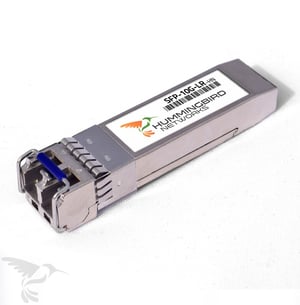
The SFP and SFP+ formats are a wonderful invention, allowing a single piece of hardware - like a switch or firewall - to accommodate a wide variety of cable and connection types, simply by swapping out the connector being used. Unfortunately, this also means that finding the right SFP/SFP+ transceiver for your application can sometimes be confusing and difficult, because of just how many connection types exist.
We tend to get a lot of questions about various types of Cisco-compatible 10g SFP+ transceivers, the differences between them, and which to use. While not totally comprehensive, we wanted to address some of the most common inquiries we get about these popular and widely-used transceivers.
 Answering Your Common Questions About Cisco SFP Transceivers
Answering Your Common Questions About Cisco SFP Transceivers
1 -How are single-mode and multi-mode fiber different?
The primary difference is how light is transmitted through the two fiber types. Single-mode uses a single relatively straight beam of light, transmitted directly through a core of glass (or occasionally plastic) that's usually 50 microns across. Single-mode accommodates large power levels, and is almost exclusively used for Long Range (LR) applications.
Multi-mode cable is more complex. It utilizes multiple beams, which bounce diagonally throughout a somewhat larger (62.5 micron) core. The beams are then collected at the receiving end and recombined. This allows multi-mode to achieve high speeds at a lower power use -and usually slightly lower cost- but the nature of the format means that interference and signal degrading become an issue in longer cables. So multi-mode is generally used for Short Reach (SR) applications.
 2 - What's the difference between SFP-10G-SR and SFP-10G-LR?
2 - What's the difference between SFP-10G-SR and SFP-10G-LR?
This one is actually pretty easy. SR stands for Short Reach, and LR stands for Long Reach. SR transceivers are almost always multi-mode, and optimized for high speeds over relatively short distances. However, the much higher-powered OM3 and OM4 formats can push that into the hundreds of meters for a single cable.
LR transceivers are designed for long-range communications, such as wiring buildings together on a large campus or even setting up a Metro Area Network (MAN). They can be either multi-mode or single-mode, and are almost always intended for 100m+ applications. Higher end cables and transceivers can support transmissions of several kilometers.
 3 - What are SFP-10G-ER and SFP-10G-ZR?
3 - What are SFP-10G-ER and SFP-10G-ZR?
Basically, these are just extremely long-range fiber variations. ER stands for Extended Reach, and can achieve transmission distances of up to 40km over single-mode fiber.
ZR is actually an unofficial format, which is not technically part of the IEEE 802.3ae standards for networking hardware. It pushes the range of single-mode ER fiber out to 80km, or about 50 miles. Several hardware manufacturers - including Cisco - have their own implementations of ZR, but they aren't necessarily cross-compatible.
4 - What does -X signify, as in SFP-10G-LR-X or SFP-10G-SR-X?
Whenever you see -X, that means it has extended ability to operate under wider temperature variation, from -40°C to 85°C (-40°F to 365°F). There is no other significant difference from the standard versions, and no reason to use -X equipment unless you're operating in extreme temperatures.
By comparison, standard transceivers are generally restricted to operating temperatures from about 0°C to 70°C (32°F to 158°F).
3 - What are Cisco "S-Class" transceivers and how are they different?
"S-Class" is a somewhat confusing standard Cisco introduced a couple years ago. It could be seen as the "budget" standard - it costs significantly less than other multigigabit SFP+ standards, but also has a reduced feature set. The idea was to create transceivers that only incorporated the features most commonly seen in enterprise and data center applications.
Basically, S-Class:
- Only supports Ethernet,
- Does not support Optical Transfer Network (OTN) or Wide Area Network Physics (WAN-PHY) standards,
- Has reduced temperature tolerances, and
- Is not necessarily TAA (Trade Agreements Act) compliant.
Aside from these differences, an S-Class transceiver is identical to the equivalent non S-Class variation. So, for most standard applications, S-Class is fine and will save some money compared to other Cisco transceivers.
Of course, Cisco-brand transceivers will cost you a lot in any case, and unnecessarily so...
Turn To Hummingbird Networks For Your Transceiver Needs
Choose Hummingbird Networks and save money! Our own Hummingbird-brand transceivers are 100% compatible and truly no different aside from the name on the casing. How do we do it? Because other name-brand transceivers are incredibly overpriced, relative to production costs. It truly is that simple.
To learn more about Hummingbird Networks brand transceivers, or for a deeper consultation on your specific transceiver needs, just contact us!










